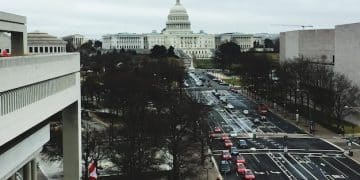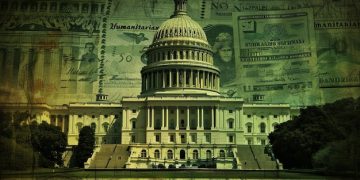Understanding the Economic Impact of the 2025 Federal Budget on US Households

Understanding the potential economic impact of the 2025 Federal Budget on US Households requires analyzing its provisions, projected spending, and potential effects on inflation, employment, and income distribution, offering insight for financial planning.
The federal budget plays a pivotal role in shaping the economic landscape of the United States, impacting everything from job creation to household finances. Understanding the potential economic impact of the 2025 Federal Budget on US Households is crucial for families to make informed decisions about their financial future.
What to Expect from the 2025 Federal Budget
The federal budget is more than just a collection of numbers; it’s a policy document that outlines the government’s spending priorities. To truly grasp its impact, we must first understand its key components and projected areas of focus.
Key Components of the Federal Budget
The federal budget is composed of various elements, each playing a crucial role in the allocation of resources. These components include mandatory spending, discretionary spending, and revenue projections.
Mandatory Spending: This refers to spending that is required by law, such as Social Security, Medicare, and other entitlement programs. These programs are often considered “untouchable” during budget negotiations, making them a significant portion of the federal budget.
Discretionary Spending: This is the portion of the budget that Congress can adjust each year. It includes funding for defense, education, transportation, and other government agencies. Due to its flexibility, discretionary spending is often a focal point of political debate.
Revenue Projections: These are estimates of how much money the government expects to collect through taxes and other sources. Accurate revenue projections are essential for creating a balanced budget and avoiding deficits.
Projected Areas of Focus in the 2025 Budget
Staying informed about the areas of priority is key to see how the new budget can affect your family.
- Infrastructure Investment: The 2025 budget is likely to continue to emphasize infrastructure investment, including projects related to transportation, energy, and broadband access.
- Healthcare: Given the rising costs of healthcare, the budget is expected to address issues related to affordability, access, and quality.
- Education: Funding for education programs, including early childhood education, K-12, and higher education, will likely be a key priority.
- Climate Change: Investment in clean energy and climate resilience initiatives is expected to be a central focus of the 2025 budget.
In conclusion, understanding the key components and projected areas of focus in the 2025 federal budget is the first step toward assessing its potential economic impact on US households. It gives a solid foundation for further delving into how it may impact different levels of society.
Impact on Employment and Job Creation
One of the most significant ways the federal budget affects US households is through its impact on employment and job creation. Government spending can stimulate economic growth, leading to increased hiring and lower unemployment rates.

How Government Spending Can Stimulate Job Growth
Government spending can act as a catalyst for job creation in several ways, that include:
Infrastructure Projects: Investments in infrastructure, such as roads, bridges, and public transportation, can create construction jobs and support related industries.
Research and Development: Government funding for research and development can lead to technological advancements and the creation of new industries, generating high-skilled jobs.
Education and Training: Investments in education and job training programs can equip workers with the skills needed to succeed in a changing economy, leading to increased employability and higher wages.
Potential Job Losses Due to Budget Cuts
However, budget cuts can have the opposite effect, leading to job losses and slower economic growth. Reductions in government spending can result in layoffs in the public sector and decreased demand for goods and services from private-sector businesses. Areas that might suffer due to budget cuts are:
- Public Sector Jobs: Cuts in government spending can lead to layoffs in government agencies and reduced hiring, particularly in areas such as education, healthcare, and public safety.
- Private Sector Jobs: Decreased government demand for goods and services can negatively impact private-sector businesses, leading to job losses in industries that rely on government contracts or funding.
- Ripple Effects: Job losses in one sector can have ripple effects throughout the economy, leading to decreased consumer spending and further job losses in other sectors.
In conclusion, the impact of the federal budget on employment and job creation is a complex issue with both positive and negative potential consequences. By understanding how government spending and budget cuts can affect job growth, US households can better prepare for the economic changes that lie ahead.
Effects on Income and Wealth Distribution
The federal budget also plays a critical role in shaping income and wealth distribution in the United States. Through various tax policies and social programs, the government can influence how wealth is distributed among different segments of the population.
Tax Policies and Their Impact on Different Income Groups
Tax policies have a direct impact on the amount of disposable income available to different income groups. Progressive tax systems, where higher earners pay a larger percentage of their income in taxes, can help to reduce income inequality. Regressive tax systems, where lower earners pay a larger percentage of their income in taxes, can exacerbate income inequality.
Progressive Taxation: Tax policies that impose higher tax rates on higher income earners can help to redistribute wealth and provide resources for social programs that benefit lower-income households.
Regressive Taxation: Tax policies that disproportionately burden lower-income earners, such as sales taxes or excise taxes, can exacerbate income inequality and make it harder for low-income families to make ends meet.
Tax Loopholes and Deductions: Tax loopholes and deductions that disproportionately benefit high-income earners can further skew income distribution and reduce the effectiveness of progressive tax policies.
Social Programs Aimed at Reducing Poverty
Social programs such as food stamps and other social welfare can make a whole lot of difference in reducing the gap among different levels of society.
- Supplemental Nutrition Assistance Program (SNAP): SNAP provides low-income families with financial assistance to purchase groceries, helping to reduce food insecurity and improve nutrition.
- Earned Income Tax Credit (EITC): The EITC provides a tax credit to low- and moderate-income workers, helping to supplement their earnings and reduce poverty.
- Housing Assistance: Programs such as Section 8 housing vouchers provide low-income families with assistance to afford safe and stable housing, reducing homelessness and improving living conditions.
- Medicaid: Medicaid provides healthcare coverage to low-income individuals and families, ensuring access to essential medical services and improving health outcomes.
In conclusion, the federal budget’s effects on income and wealth distribution are significant and far-reaching. By understanding how tax policies and social programs impact different income groups, US households can better advocate for policies that promote a more equitable distribution of wealth.
Effects on Inflation and Consumer Prices
Inflation, the rate at which the general level of prices for goods and services is rising, is another key area influenced by the federal budget. Government spending and monetary policy can both have a significant impact on inflation and consumer prices.

How Government Spending Can Drive Inflation
When the government spends more money than it collects in revenue, it can lead to increased demand for goods and services. If supply cannot keep up with demand, prices may rise, leading to inflation.
Increased Demand: Government spending can stimulate demand for goods and services, leading to higher prices if supply cannot keep up.
Supply Chain Disruptions: Government policies, such as tariffs or trade restrictions, can disrupt supply chains and lead to higher prices for imported goods.
Wage-Price Spiral: Increased government spending can lead to higher wages, which in turn can lead to higher prices as businesses pass on those costs to consumers.
Impact of Monetary Policy on Controlling Inflation
Monetary policy, controlled by the Federal Reserve, plays a crucial role in managing inflation. The Federal Reserve can raise interest rates to cool down the economy and reduce inflation, or lower interest rates to stimulate economic growth and prevent deflation. Some measures include:
- Raising Interest Rates: The Federal Reserve can raise interest rates to make borrowing more expensive, which can cool down the economy and reduce inflation.
- Lowering Interest Rates: The Federal Reserve can lower interest rates to make borrowing cheaper, which can stimulate economic growth and prevent deflation.
- Quantitative Easing: The Federal Reserve can engage in quantitative easing, which involves buying government bonds to inject liquidity into the financial system and lower interest rates.
In conclusion, the federal budget’s effects on inflation and consumer prices are complex and multifaceted. By understanding how government spending and monetary policy can influence inflation, US households can better prepare for changes in the cost of living and make informed financial decisions.
Impact on Specific Sectors: Healthcare, Education, and Energy
The federal budget’s impact varies significantly across different sectors of the economy. Healthcare, education, and energy are three critical sectors that are particularly sensitive to changes in government funding and policies.
Healthcare: Funding Changes and Their Effects
Changes in healthcare funding can have a profound impact on access to care, the quality of services, and the overall cost of healthcare for US households. Some of those potential impacts are:
Access to Care: Increased funding for programs like Medicaid and the Affordable Care Act can expand access to healthcare for low-income individuals and families.
Quality of Services: Funding for research and development can lead to advancements in medical technology and improved healthcare outcomes.
Healthcare Costs: Changes in government policies, such as price controls or regulations on insurance companies, can affect the overall cost of healthcare for US households.
Education: Investments in Schools and Student Aid
Making adequate investments in education can have a long-lasting impact on individual opportunities, economic growth, and social mobility. Possible areas to invest:
- Early Childhood Education: Funding for early childhood education programs like Head Start can provide children from low-income families with a strong foundation for future success.
- K-12 Education: Investments in K-12 education can improve the quality of schools, reduce class sizes, and provide students with the resources they need to succeed.
- Student Aid: Increases in student aid programs can make college more affordable for low- and middle-income students.
Energy: Green Initiatives and Fossil Fuel Subsidies
Government policies related to energy, such as investments in renewable energy or subsidies for fossil fuels, can have a significant impact on energy prices, environmental quality, and the transition to a clean energy economy.
Renewable Energy: Investments in renewable energy sources like solar, wind, and geothermal can reduce reliance on fossil fuels and lower carbon emissions.
Fossil Fuel Subsidies: Subsidies for fossil fuels can encourage the continued use of these resources, contributing to climate change and air pollution.
In conclusion, the federal budget’s impact on specific sectors such as healthcare, education, and energy is complex and multifaceted. By understanding how government funding and policies affect these sectors, US households can better advocate for policies that align with their values and priorities.
Strategies for Households to Adapt and Plan Ahead
Given the potential economic impacts of the 2025 federal budget, it is essential for US households to develop strategies to adapt and plan ahead.
Budgeting and Saving Strategies
Creating a budget and saving regularly is fundamental when trying to be responsible towards the potential impacts of the changes in economic sectors.
Creating a Budget: Developing a budget can help households track their income and expenses, identify areas where they can cut back, and set financial goals.
Saving Regularly: Setting aside a portion of each paycheck for savings can provide a financial cushion in case of unexpected expenses or economic downturns.
Emergency Fund: Building an emergency fund can help households cover unexpected expenses, such as medical bills or job loss, without having to rely on credit cards or loans.
Investment and Retirement Planning
Investing wisely and planning for retirement are crucial steps for US households to secure their financial future. Some measures include:
- Diversifying Investments: Diversifying investments across different asset classes, such as stocks, bonds, and real estate, can help to reduce risk and increase returns.
- Retirement Savings: Contributing to retirement accounts, such as 401(k)s or IRAs, can help households save for retirement and take advantage of tax benefits.
- Financial Advisor: Consulting with a financial advisor can provide personalized guidance on investment and retirement planning.
Staying Informed and Engaged
Remaining on top of things means participating in decision making through voting and petitions. It includes:
Following Economic News: Staying informed about economic trends, government policies, and financial news can help households make informed decisions about their finances.
Contacting Representatives: Contacting elected officials can allow households to voice their concerns and advocate for their interests.
In conclusion, adapting to changes in economic scenarios requires a combination of the right information and preparation of different areas of your life. With a good plan, households can navigate through an ever evolving economic landscape.
| Key Aspect | Brief Description |
|---|---|
| 📊 Budget Focus | Prioritizes infrastructure, healthcare, education, and climate initiatives. |
| 💼 Job Impact | Stimulates job growth via infrastructure and R&D, but cuts may cause losses. |
| 💰 Wealth Distribution | Influenced by tax policies and social programs; progressive taxes reduce inequality. |
| 📈 Inflation Risks | Government spending can drive inflation; monetary policy aims to control it. |
Frequently Asked Questions
The federal budget affects household income through tax policies, employment opportunities, and social programs. Changes in these areas can increase or decrease your disposable income.
Healthcare, education, and energy sectors are generally the most affected due to significant funding allocations and policy changes impacting costs and access.
Prepare by creating a detailed budget, saving regularly, diversifying investments, and staying informed about economic news and policy changes.
Monetary policy, controlled by the Federal Reserve, helps manage inflation by adjusting interest rates to cool down or stimulate the economy as needed.
Social programs like SNAP, EITC, and housing assistance provide low-income families with financial support to cover essential needs, reducing poverty levels.
Conclusion
Understanding the potential economic impact of the 2025 federal budget on US households is essential for effective financial planning and informed civic engagement, enabling families to navigate economic changes and advocate for beneficial policies.





